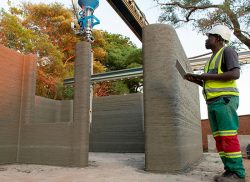
Although still a very niche concept, the technology has improved over the last 10 years and the costs have come down significantly. Just like an inkjet printer, 3D printers for construction rely on a software programme – CAD or BIM – to ‘tell’ them about the dimensions of the end product so that they can inject material on a platform meeting the precise measurements.
Kenya is among the first African countries to test the concept of 3D construction as a way to build affordable homes. 3D printing in construction can include deploying a 3D printer attached to a robotic arm to build a house on-site, or the use of printers off-site to create components of a building that are later assembled on-site.
Although still a very niche concept, the technology has improved over the last 10 years and the costs have come down significantly. Just like an inkjet printer, 3D printers for construction rely on a software programme – CAD or BIM – to ‘tell’ them about the dimensions of the end product so that they can inject material on a platform meeting the precise measurements.
3D printers can work with liquid metals, plastics, cement and a variety of other materials to form structures. A partnership between Franco-Swiss cement multinational firm, LafargeHolcim and CDC Group in early 2021 through a joint venture called 14Trees saw the first affordable 3D-printed house in Kenya built in just 12 hours at a cost of only USD10,000 (KSh1.1 million).
3D constructions can reduce CO2 emissions by as much as 70 per cent compared to typical house-building projects, making them ideal for clients keen on protecting the environment but also seeking low-cost solutions for constructing homes.
The rapid urbanisation taking place in Kenya and Africa today calls for technological solutions to lower the cost of building affordable housing. However, for 3D-printed homes to become a reality, the technology will need to rapidly scale up acceptance in the construction sector where profit margins a usually razor-thin.
One solution is public private partnerships (PPPs) where the Government works with private sector players and also provides them with incentives to lower the cost of investing in the required equipment. The 14Trees building projects are one example of such public-private cooperation helping to create jobs as well as housing across Africa.
The IFC is working with a Chinese multinational construction and engineering company, CITIC Construction, and plans to build 30,000 homes over a five-year period by partnering with local businesses across Africa and estimates that each housing unit will create five full-time positions, equating to 150,000 new jobs in all.
“As sub-Saharan Africa becomes more urbanised, the private sector can help governments meet the critical need for housing”, Oumar Seydi, IFC Director for Eastern and Southern Africa writes on the IFC website. “The platform will help transform Africa’s housing markets by providing high quality, affordable homes, creating jobs, and demonstrating the viability of the sector to local developers.”

There are a few major 3D constructions worth noting:
- Dubai municipality office building in the UAE built in December 2019 by 3D robotics firm Apis Cor. It is the world’s largest individual 3D printed building, rising 9.5 metres in height and has with a floor area of 640 m2. The 3D printer had to be moved around the site by a crane to build different parts of the structure.
- Office of the Future, also in Dubai that currently houses the emirate’s Future Foundation. The Dubai, another construction superpower, currently has the world’s most ambitious policy to promote automated construction: an official 3D Printing Strategy. It was launched by Sheikh Mohammed bin Rashid Al Maktoum in 2016 who announced a target for the emirate to construct 25 percent of buildings using 3D-printers by 2030. The 2,700 structure was the world’s first fully occupied office complex to be built with 3D-printing technology. Its construction is a collaboration between WinSun Decoration Design Engineering Co, Gensler, Thornton Tomasetti, Syska Hennessy Group, and Dubai-based Killa Architectural Design, and was also created layer by layer via a gantry-mounted 3D printer. Printing was done offsite in 17 days. Workers then installed the whole building in just 48 hours.
- A small apartment block 3D printed by WinSun in China using factory-based 3D printers.
- A five-story residence in Suzhou, China which is also the world’s tallest 3D-printed building by WinSun.
- The world’s first 3D-printed villa in a not-so-subtle French Second Empire style, also by Winsun.
A recent article in the UK newspaper, The Guardian detailed how scientists developed a way to construct 3D-printed and “environmentally friendly buildings using local soil that they say has the potential to revolutionise the construction industry.”
They see this as an alternative to concrete whose production is energy intensive and leaves a harmful carbon footprint. Research by the International Energy Agency (IEA), according to the article, shows that concrete alone accounts for 7 per cent of global carbon dioxide emissions harmful to the earth’s protective ozone layer. Because it cannot be recycled and consumes a lot of energy to mix and transport, concrete remains a challenge for the construction sector.
“The use of local materials would reduce the need to transport concrete long distances, further reducing the environmental impact of the buildings,” notes the report in The Guardian. Advantages of 3D-printer construction include:
- Zero waste during construction since a 3D printer only uses what it needs to print the structure.
- Reduction of time and cost because a 3D printer can work non-stop speeding up projects and lowering labour costs.
- Support for unique construction designs that are complex because 3D printers layer up material and can mould unusual shapes not possible using traditional techniques.

Disadvantages of 3D-printer construction include:
- High Costs of R&D (research and development).
- Low acceptance as many still prefer buildings made from brick and mortar.
- Difficulties of integration with elements that do not easily lend themselves to 3D printing.
